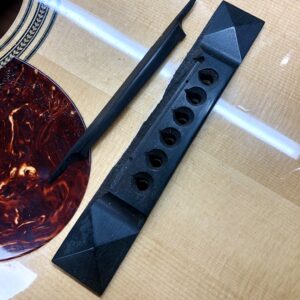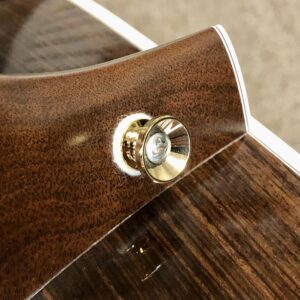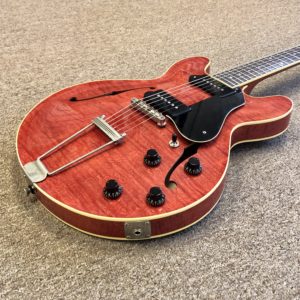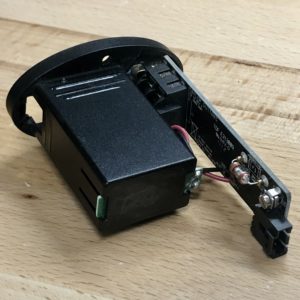Electric Guitar Pickup Replacement

Pickup replacements are a popular way for guitarists to personalize their instruments. Swapping out the stock pickups in an inexpensive guitar is often a huge tonal improvement no matter what model of replacement you chose.
While pickup installation may seem as simple as removing and replacing a few wires, there is more to a clean, reliable, installation than meets the eye. Specialized tools and ample experience are required to achieve a dependable outcome.
Wiring work is one of the most common reasons instruments visit our shop.
A job that has been improperly done is often more troublesome, time consuming, and expensive to undo and repair than if it had been done right the first time!
What Is An Electric Guitar Pickup
At its most basic level, an electric guitar pickup consists of a length of very thin wire that is wrapped thousands of times around a magnet(s), creating a “coil”. This coil is able to react to the vibration of the guitar string and convert the mechanical energy of the string into electrical energy that it then passes along to the amplifier. The conversion of one form of energy (mechanical into electrical) is called “transduction” and the pickup is the “transducer”. Understanding this process, one can see the dramatic impact that a guitar’s pickup can have on the overall tone that comes out of the amplifier.
By varying the shape of the coil, the type of magnet(s), and/or the type of wire used, makers are able to affect subtle changes on the tone that the pickup will produce once installed on your guitar.
Tips For Choosing Replacement Pickups
Calico Guitarworks is an authorized dealer for many of the leading pickup brands. The staggering quantity of replacement pickup options available can feel overwhelming. Though we have our personal favorites for specific playing styles, good tone is subjective. Only you can decide if a particular pickup sounds good to your ear.
We advise players to analyze the attributes of their current set prior to choosing a replacement. Quality pickups are not inexpensive and this is a crucial step toward ensuring a worthwhile investment.
Apart from comparing the specs that are commonly found on the manufactures website, there are a few other important things to consider to ensure a hassle free fit and installation of your new pickups.
Single Coil Pickups: 60-cycle Hum, Shielding, and RWRP Sets
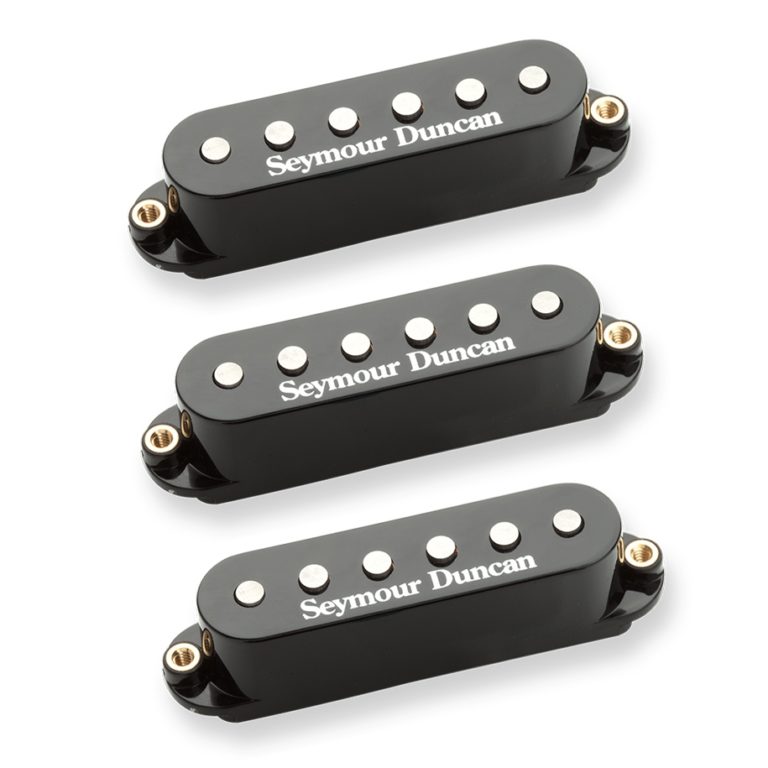
Instruments such as the Fender Stratocaster, Telecaster, and Jazz Bass all traditionally come with “single coil” pickup designs. This style of pickup produces an audible hum, inherent to their design, known as 60-cycle hum. Shielding of the guitar’s control cavities is one option to help minimize this hum.
Some sets are offered in a Reverse wound-reverse polarity (RWRP) configuration. This means that one of the pickups in the set is constructed with both the magnetic polarity (north or south) and the coil’s winding direction (clockwise or counter clockwise) opposite relative to the other(s) in the set.
This small change allows the hum that each pickup produces to cancel each other out when both pickups are used together. If your guitar’s single coil pickups get noticeably quieter when the pickup selector is in the “in-between” positions, your instrument’s pickups are RWRP relative to one another.
If you would prefer that your guitar be as quiet as possible, swapping out the single coil pickups for a “noiseless” option as discussed in our Mods and Upgrades For Fender Stratocaster and Fender Jazz Bass Mods and Upgrades might be an option that to consider.
Pickup Polarity and Pickup Phase

There is no one industry standard regarding coil winding direction, which of the magnets two poles should face up (polarity), or what different colors of wire should indicate. As such, when combining pickups that have not been designed to work together as a calibrated set, troubleshooting is often required to attain compatibility between the components.
When individual pickups are combined with one another, the relationship between the magnetic polarity (north or south) and the winding direction (clockwise or counterclockwise) of each pickup has a profound effect on the sound.
Generally, combined pickups should have ether both OPPOSITE winding direction AND polarity, as in the RWRP sets mentioned above, or IDENTICAL winding direction AND polarity. While the latter pickup combination would not be hum cancelling, they will reproduce the sound fully and accurately.
If two pickups are mismatched, (opposite polarity/same winding direction or same polarity/opposite winding direction) the pickups will sound weak when combined. The sound is often described as “thin” and lacking particularly in the lower bass frequencies. The term for this type of relationship is called “out of phase”. While the resulting sound has occasionally been used on purpose as a special effect, it is usually accessed via a toggle switch so that it can be turned on and off for brief passages when desired. Most players would not like this to be the fixed setting for their instruments pickups.
Bridge Pickup Spacing For Humbucking Pickups
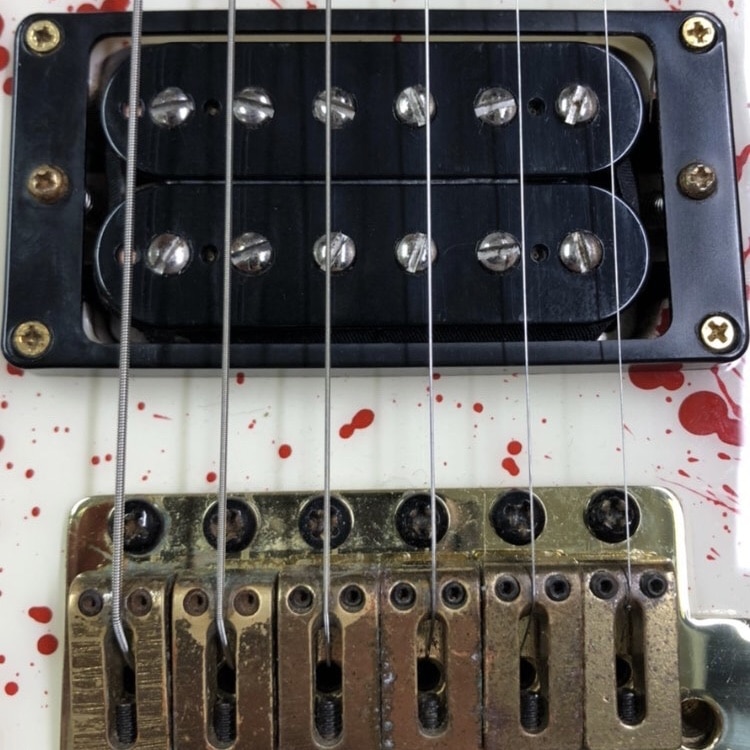
The string spacing on your guitar gets wider as it moves from the string nut to the bridge of the instrument. This means that, due to their locations on the body, a neck position pickup will see a different string spacing than the bridge position pickup.
On single coil pickup equipped guitars, this issue is usually delt with by angling the mounting of the bridge pickup. With humbucking style pickups, since they are traditionally installed perpendicular to the strings, it is often beneficial to have a wider pole-piece spacing for a bridge pickup vs. the neck position.
While it is not critical that every string line up perfectly over the top of the pickup’s pole-pieces, wildly mismatched pickup string alignment can lead to uneven string to string output.
This is especially true on “Fender style” guitars with a tremolo bridge, which typically have a wider string spacing than guitars made in the “Gibson style”. For marketing purposes, Seymour Duncan coined the word “Trembucker”, while Dimarzio and a few other brands use the term “F-spaced” to refer to humbucking pickups that are designed with a wider pole piece spacing intended for the bridge position on “fender style” and other tremolo equipped guitars.
As a general rule of thumb, if the string spacing above the pickup measures 2″ or more from E string to E string, an F-spaced or Trembucker spaced pickup will result in the strings better aligning the the pickup and thus having a more balanced output.
Consider Pickup Cavities and Routing
Pickup shape and mounting style varies. For example, humbucking pickups can have different styles of mounting “legs”, be covered or uncovered, and they can be mounted to pickguards, trim rings, or surface mounted directly to the guitars top. Sometimes fitting or routing is necessary to accommodate a desired pickup swap. In the case of hollow bodied guitars, oftentimes the wiring harness must be pulled to access the electronics.
Closing Thoughts
The above are some of the most commonly overlooked aspects of pickup installation. It is our sincere hope that this information will assist players in making an informed decision before purchasing replacement pickups for their instruments and to understand some common complications that can affect their proper installation.

Erik Salomon - Calico Guitarworks Owner / Head Technician
Tech Talk articles are part of an ongoing effort to provide clear and detailed answers to common questions about guitar maintenance, modifications, and repairs.
While not intended as a step-by-step guide to servicing your own instrument, we hope that you will find value in the information provided.

Great Repairs Start With The Right Parts
Many of the parts mentioned in our blogs are available for purchase at:
GuitarRepairParts.com
Enter the code "TechTalk10" at checkout for 10% off your first order.
About Calico Guitarworks
Calico Guitarworks is the area’s premier destination for fretted musical instrument care and maintenance. Owned and managed by Erik Salomon, the shop is dedicated to providing quick, honest and reliable service. The staff at Calico Guitarworks has a combined 25+ years of professional guitar repair experience. Sharing the knowledge that we accumulate in this focused pursuit is at the core of what we do. Learn more About Calico Guitarworks, explore our Frequently Asked Questions, or Contact us with a specific request.

